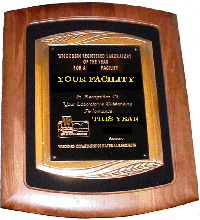Laboratory certification & registration program
The Wisconsin Department of Natural Resources (DNR) Laboratory Certification Program was created in 1986 to help ensure that laboratories submit reliable and consistent data to the department's various environmental programs. The program currently offers accreditations designed to accommodate the needs of many DNR programs including testing under the Clean Water Act, Resource Conservation and Recovery Act and the Safe Drinking Water Act.
Background
The program operates under Chapter NR 149 of the Wisconsin Administrative Code, which sets very specific requirements for certified and registered laboratories. Ch. NR 149 sets the scope of the available fields of accreditation and the fees for each. Available fields of accreditation are defined by Matrix-Technology-Analyte (group) for aqueous and solid matrices and Matrix-Method-Analyte (group) for the drinking water matrix. This allows a laboratory some flexibility in choosing which types of analyses and which approved technologies/methods they wish to be certified or registered for, thereby limiting their certification costs. The fees charged to laboratories participating in the program are considerably lower than similar programs in many other states.
Analyte groups
Analyte groups explained
"Analyte group" is defined in s. 149.03 (5) as: "Analyte group" means a set of analytes that can be determined using the same method or technology and that constitute a unit, acknowledged by the department, of the third tier of certification or registration.
The selection of an analyte group for certification or registration means that your certification/registration for the group extends to all analytes that make up that group. The following analyte groups have been established; each of these groups is available for accreditation in either the Aqueous or Solid matrices.
- BNA analyte group (Technology = GC/MS)
- VOC analyte group (Technology = GC)
- VOC analyte group (Technology = GC/MS)
- PAH analyte group (Technology = GC/MS)
- PAH analyte group (Technology = HPLC or GC)
- Pesticides, Organochlorine analyte group (Technology = GC)
- Pesticides, Organochlorine analyte group (Technology = GC/MS)
- PCB as Aroclors analyte group (Technology = GC or GC/MS
- PCB Congeners analyte group (Technology = GC, GC/MS, or HRGC/MS)
- Dioxins & Furans analyte group (Technology = GC/MS, or HRGC/MS)
Newsletter
LabNotes - LabCert program newsletter
LabNotes is a publication of the Laboratory Certification and Registration Program. The newsletter highlights program information and current events and is distributed to all Wisconsin certified and registered laboratories nationwide. To reduce costs and as a "green" approach, we no longer produce a hard copy for mailing. We will be looking into establishing a GovDelivery list that will allow anyone to receive an e-mail as new information is provided.
Editions of LabNotes are available in PDF (Portable Document Format) readable by the Adobe Acrobat Reader, which is freeware.
Current edition of LabNotes
Recent editions of LabNotes
| Year | Edition 1 | Edition 2 |
|---|---|---|
| 2018 | Winter 2018 | |
| 2016 | Fall 2016 | |
| 2015 | Spring 2015 | Fall 2015 |
| 2013 | Winter 2013 | |
| 2009 | Fall | |
| 2008 | Spring | |
| 2007 | Winter | Summer |
| 2006 | Winter | Summer |
| 2005 | Summer |
Lab-of-the-Year awards
Registered laboratory of the year award program
The Natural Resources Board presents annually at the March meeting the Registered Lab-of-the-Year awards, which debuted in 1996. The awards are intended to recognize those laboratories that have developed exceptional systems for producing high-quality data. Only registered laboratories are eligible for consideration.
Small laboratories are designated as those facilities having daily effluent flows under 1 MGD and those facilities that perform testing limited to standard wastewater analyses (BOD, ammonia-nitrogen [NH3], total phosphorus [TP] and total suspended solids [TSS]).
Large laboratories are designated as those facilities having daily effluent flows in excess of 1 MGD or those facilities that perform testing that includes parameters outside of standard wastewater analyses (BOD, ammonia-nitrogen [NH3], total phosphorus [TP] and total suspended solids [TSS]).
Low level mercury
Laboratory accreditation & low-level mercury
Wisconsin DNR began recognizing laboratories' low-level mercury capabilities in 1997 in support of the Department's mercury strategy for wastewater permits. The Department recognizes that it may not be necessary to use the most sensitive technique for all permit-related samples, so facilities have some flexibility in selecting a laboratory. It is important to note that holding the requisite certification for low-level mercury is not in itself a guarantee that reported results will be accepted for compliance testing.
- Program documents
- Wisconsin's mercury strategy & monitoring
- Low-level mercury - analytical considerations
Requirements
To report low-level mercury results to DNR, laboratories must be properly accredited for the field of testing aqueous (matrix) - Ultra low level metals assays (technology) - mercury (analyte) under ch. NR 149 and then demonstrate their ability to meet performance-based criteria established by the Department. Although laboratories have flexibility in the method used, sample results must be quantifiable unless the sample concentration is below the water quality criterion. Laboratories must report results to their detection limit.
The DNR is committed to obtaining quality low-level mercury data, and, in addition to other performance-based criteria, laboratories must be able to demonstrate the ability to achieve a detection limit (LOD) of 0.2 ng/L (0.0002 ug/L) or lower to obtain certification. The limit of quantitation (LOQ) must be no greater than 0.5 ng/L (0.0005 ug/L). The on-site evaluation process will be used to verify a given laboratory's ability to produce quality mercury data.

